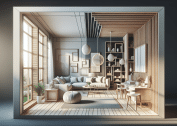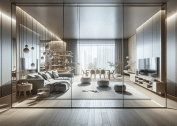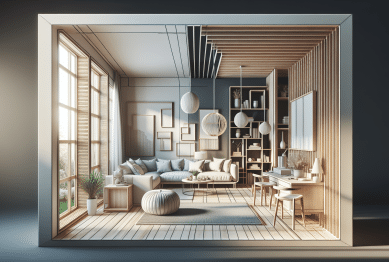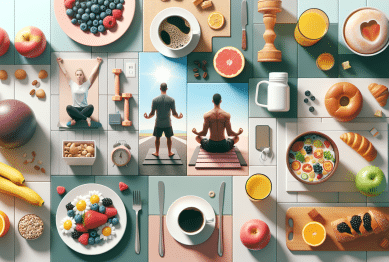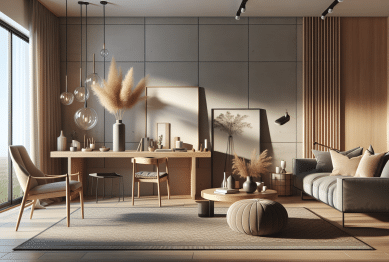Discover practical strategies to transform any living space into a personal sanctuary that promotes relaxation and well-being. Explore design trends, space-saving ideas, wellness-focused décor, and the psychology behind what truly makes a home feel special—all while balancing style with comfort in busy lifestyles.
Understanding the Psychology of Spaces
Many people underestimate the powerful influence that home environments have on daily mood and general well-being. The arrangement, light, and décor choices in your home can impact energy levels, concentration, and even sleep quality. Studies show that cluttered or poorly designed interiors may increase stress or anxiety, while thoughtful home design can cultivate calm, creativity, and a true sense of refuge (Source: https://www.ncbi.nlm.nih.gov/pmc/articles/PMC6010636/). Building a home sanctuary means designing with intention, considering emotional as well as physical needs.
Subtle changes, like adding indoor plants or optimizing the use of natural sunlight, have been associated with improved concentration and restorative effects. Spaces that minimize visual noise can provide immediate relief from the sensory overload common in fast-paced lifestyles. Incorporating zones dedicated to relaxation, reading, or meditation ensures each room serves a clear purpose and becomes part of an overall feel-good routine.
Research suggests that exposure to soft textures, neutral color palettes, and mindful lighting helps reduce psychological tension. Designing areas for quiet reflection or creative pursuits can contribute to emotional resilience over time (Source: https://www.ncbi.nlm.nih.gov/pmc/articles/PMC8505672/). In fact, many individuals find the act of curating their space an empowering step toward self-care. Creating a home sanctuary begins with recognizing this unique interplay between design and emotional wellness.
Blending Wellness Features Into Your Home
Integrating wellness-focused design elements into homes is increasingly popular. Features such as aromatherapy diffusers, Himalayan salt lamps, or spaces dedicated to gentle yoga encourage routines that align with wellness goals. Smart lighting systems can adjust brightness and color temperature, enhancing circadian rhythms and supporting restful evenings (Source: https://www.sleepfoundation.org/sleep-environment/light).
For many, a home sanctuary is inseparable from holistic living principles—promoting nutrition, mental health, and relaxation. Kitchens can be tailored to simplify healthy meal preparation, with good lighting, decluttered worktops, and designated zones for different activities. In living areas, soft seating and cozy corners foster social interaction or rest, supporting both community and solitude as needed.
Mental well-being can be enhanced by technology-influenced spaces. For example, noise-cancellation devices or integrated sound systems allow soothing nature sounds or music therapy sessions. Some individuals find relief in designated digital detox zones, where devices are left outside in favor of books, art supplies, or mindfulness practices. These home features signal a growing desire to put health and relaxation at the center of daily life.
Smart Storage Solutions for Serenity
Decluttering stands at the core of building a restful home environment. Smart storage solutions, such as multi-use furniture, stacked shelving, or hidden compartments, free up valuable space and keep living areas visually calm. Minimalist living room arrangements, paired with clever organizational strategies, let even small apartments feel open and inviting (Source: https://www.apa.org/monitor/2019/03/cover-clutter).
The philosophy of “less is more” extends beyond aesthetics—it’s about reducing daily decision fatigue. Simple storage baskets, labeled cabinets, or streamlined closet organizers can turn routine tidying into a manageable, even satisfying ritual. Many find that creating homes with clear surfaces and designated places for everyday essentials directly supports mental clarity and relaxation habits.
Customization can be fun and practical. Tailoring storage zones to the unique needs of a household ensures lasting order and convenience. Playrooms with toy bins, bedroom headboards with built-in shelving, and entryway benches storing shoes exemplify adaptable sanctuary-building. The right storage not only hides clutter but also reflects personal lifestyle and values.
Personalizing With Mindful Décor
Your home sanctuary should reflect individual tastes and cherished memories. Personalized décor can range from family photographs set in natural wood frames to art made by local creators. Mindful choices, like using sustainable materials or handmade ceramics, add character and warmth, while also supporting ethical lifestyle practices (Source: https://www.slowfood.com/slow-home-movement/).
Color psychology plays a significant role in setting the mood of each room. Cool blues and earthy greens can produce a calming effect, while pops of color—perhaps a vivid cushion or abstract wall art—inject cheerful energy. Many opt for layered textures through throws, rugs, and cushions, boosting comfort while promoting a sense of security and relaxation throughout the home.
Bringing the outdoors inside remains a timeless trend. Indoor plants, natural fiber baskets, and stone or wood accents not only please the eye but may also offer air-purifying or stress-reducing benefits. Curating décor with natural themes reinforces the feeling of belonging and comfort—a key to turning a house into a personal sanctuary.
Transforming Small Spaces Into Retreats
Even the smallest apartments or studios can be adapted into restorative environments. Utilizing vertical space for shelving, choosing lightweight furniture, and incorporating mirrors to amplify natural light make compact homes functionally spacious. Room dividers and folding screens carve out privacy for work, rest, or creative activities when square footage is at a premium (Source: https://www.architecturaldigest.com/gallery/small-apartment-design-ideas).
Multi-purpose pieces—such as ottomans that double as storage chests or desks that convert into dining tables—can adapt to changing needs. Soft textiles or curtain panels soften visual boundaries and help define zones for different daily functions. Sliding doors or moveable screens offer the ability to instantly change the layout, making any space feel more flexible and tailored to lifestyle shifts throughout the day.
Balance is important when adding personality to small spaces. Carefully selected décor that avoids overwhelming visual clutter will support calm. Many people experiment with wall-mounted lighting, floating shelves, and compact accessories to maintain open floors and encourage easy movement—a smooth path to relaxation, no matter how limited the square footage might be.
Embracing the Evolving Home Sanctuary Trend
The concept of a home sanctuary has evolved, embracing flexible lifestyles and changing well-being needs. Open-plan layouts, moveable furniture, and convertible spaces enable easy adaptation as life circumstances shift. Current trends emphasize adaptability, empowering more people to experiment with design until it feels just right (Source: https://www.houzz.com/magazine/see-how-homes-are-evolving-into-healthier-sanctuaries-stsetivw-vs~138434915).
The growing attention to mental and emotional wellness has solidified the sanctuary approach as more than just a trend. For many, a home is not simply a place to live, but a foundation for self-care, growth, and inspiration. Taking time to thoughtfully transform environments helps reinforce health-oriented routines and long-term happiness.
Exploring the diversity in how people around the world design sanctuaries at home can offer surprising inspiration. Elements such as tatami meditation spaces or Scandinavian “hygge” corners show how traditions from many cultures influence contemporary sanctuary design. The journey toward building a home sanctuary is ongoing, inviting experimentation and personal expression at every turn.
References
1. Ghamari, H., & Amor, C. (2018). Influence of interior design on well-being. Retrieved from https://www.ncbi.nlm.nih.gov/pmc/articles/PMC6010636/
2. Baldwin, C., & Tomkinson, J. (2021). The built environment and mental health. Retrieved from https://www.ncbi.nlm.nih.gov/pmc/articles/PMC8505672/
3. Sleep Foundation. (n.d.). Light and sleep. Retrieved from https://www.sleepfoundation.org/sleep-environment/light
4. American Psychological Association. (2019). The cost of clutter. Retrieved from https://www.apa.org/monitor/2019/03/cover-clutter
5. Slow Food International. (n.d.). The slow home movement. Retrieved from https://www.slowfood.com/slow-home-movement/
6. Architectural Digest. (n.d.). Small apartment design ideas. Retrieved from https://www.architecturaldigest.com/gallery/small-apartment-design-ideas

